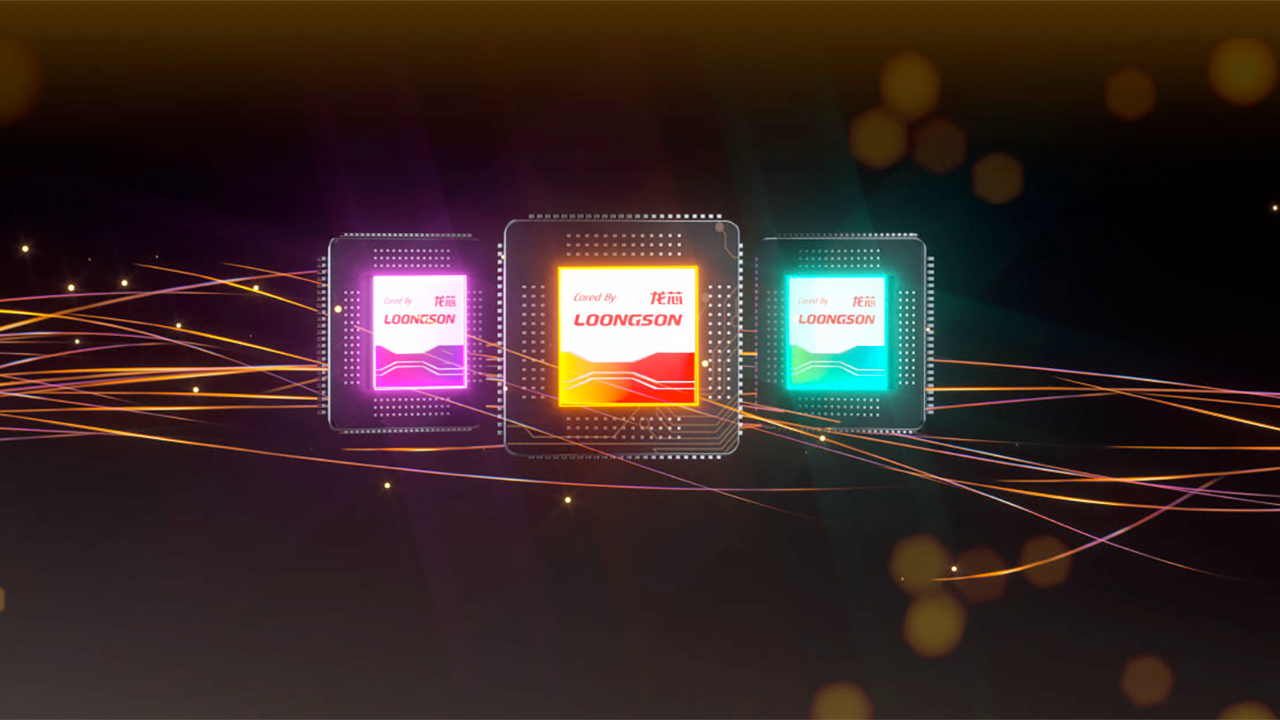Chinese chipmaker samples 128 core server CPU with chiplets — Infinity Fabric-like interconnect in Loongson's 3E6000 combines four chips into one
Get a 16-core 3C6000, or four stapled together in the 3E6000 for 64 cores.

China's domestic chip production is managing impressive feats regardless of U.S. restrictions. CPU developer Loongson announced to shareholders that its upcoming 3C6000/3D6000/3E6000 series of server-grade processors had been successfully sampled and returned and that these first chips are now being tested. Loongson plans to release the 3C6000 line in Q4 2024, exactly matching its roadmap.
Loongson's new server chip line is unique for its chiplet-based architecture. While the 3C6000 is a 16-core/32-thread processor on its own, the 3D6000 contains two 3C6000 chips connected with Loongson's "Loongson Coherent Link" technology, creating a 32-core/64-thread processor. The 3E6000 takes this up another notch, connecting four 3C6000 chiplets for a monster 64-core/128-thread beast.
Loongson compares its Coherent Link to the performance of Nvidia's NVLink, though perhaps a better comparison would be to AMD's Infinity Fabric, which enables its Zen chiplet-based architectures. The 3C6000 contains 16 LA664 cores with Loongson's LoongArch microarchitecture. Unfortunately, no information on the speed or performance claims of the 3C6000 has been confirmed, but Loongson claims the LA664 cores offer double the performance of their predecessors inside the last-gen 3C5000, which operated at 2.2 GHz. The 3C6000 family will also support up to four channels of DDR4-3200 memory.
Chiplet architectures have long been considered the future of microprocessors in a post-Moore's Law world, and nowhere is this more true than in China. As U.S. sanctions restrict Chinese chipmakers from access to advanced chip processes, chiplet architecture is viewed as a way to allow Chinese developers access to more performance in a roundabout way. However, Loongson is relatively unique in its pursuit of cutting-edge chips within China, as many chipmakers have transitioned to investing fully in legacy chip production, a niche China is dominating.
Loongson's efforts have been impressive despite regulations and Chinese industry trends moving back to legacy production. Thanks to its own in-house MIPS-based LoongArch ISA and the use of domestic Chinese fabs, Loongson can avoid U.S. trade blockades on the greater Chinese chip market. Loongson has been populating China's schools with high-power domestic chips, and its most recent chip releases meet Intel's 10th-gen single-core performance.
As China continues to ban non-domestic computers for government use, Loongson will continue to grow its market share. Intel CEO Pat Gelsinger may claim that Chinese chips are ten years behind American chips, but that may not matter for Loongson — and if the 3E6000 manages an impressive showing, it may not even be true.
Get Tom's Hardware's best news and in-depth reviews, straight to your inbox.

Sunny Grimm is a contributing writer for Tom's Hardware. He has been building and breaking computers since 2017, serving as the resident youngster at Tom's. From APUs to RGB, Sunny has a handle on all the latest tech news.
-
nookoool There is allege smooth demo of Genshin Impact running locally on the 3a6000 from a Loongson employee running via binary translation. Though far from being mainstream in China, Loongson has potential if they can figure out how to mass market it or somehow dwindle access from of wintel.Reply -
das_stig Reply
Lets be real, Chinese engineers are as good or better than western but for China to have caught up to 10th Gen performance in such a short time ..nookoool said:What was stolen?
1. They developed it from licenced IP, good possibility.
2. Developed inhouse IP, possible but doubtful in such a short time frame.
3. Stole the IP and then developed it, wouldn't be the first time and let's be honest, is probably the true answer.
If these chips ever make it to western market, you can guarantee Intel/AMD and anybody else in the chip business will be taking a very long hard look at them under a microscope and any sign of dodgy dealings will get them banned. I wouldn't even be surprised if the USA and friends just ban them from being used as a "risk to national security" -
jeremyj_83 Reply
AMD did have a license agreement with a Chinese company for a CPU that was almost identical to Zen 1. They probably took that IP and then smuggled newer Zen CPUs into the country and have cloned them.das_stig said:Lets be real, Chinese engineers are as good or better than western but for China to have caught up to 10th Gen performance in such a short time ..
1. They developed it from licenced IP, good possibility.
2. Developed inhouse IP, possible but doubtful in such a short time frame.
3. Stole the IP and then developed it, wouldn't be the first time and let's be honest, is probably the true answer.
If these chips ever make it to western market, you can guarantee Intel/AMD and anybody else in the chip business will be taking a very long hard look at them under a microscope and any sign of dodgy dealings will get them banned. I wouldn't even be surprised if the USA and friends just ban them from being used as a "risk to national security" -
Lewinator56 Reply
It probably is in house. Remember Huawei led, and still leads the industry in 5G tech, they can't have nicked that IP from the west because.... The west admit they are behind, still, let alone 5 years ago. Chinese engineers do know what they are doing.das_stig said:Lets be real, Chinese engineers are as good or better than western but for China to have caught up to 10th Gen performance in such a short time ..
1. They developed it from licenced IP, good possibility.
2. Developed inhouse IP, possible but doubtful in such a short time frame.
3. Stole the IP and then developed it, wouldn't be the first time and let's be honest, is probably the true answer.
If these chips ever make it to western market, you can guarantee Intel/AMD and anybody else in the chip business will be taking a very long hard look at them under a microscope and any sign of dodgy dealings will get them banned. I wouldn't even be surprised if the USA and friends just ban them from being used as a "risk to national security"
Loongson's uArch is pretty different to zen and skylake derivatives, chips and cheese have analysed their CPUs pretty closely and they are different enough to exclude IP theft. Stealing IP for an interconnect that can't work with your uArch is a bit stupid.
Of course the US would ban the CPUs on 'national security' grounds, but they happily let Cisco's swiss cheese equipment run core networks....
To be honest, another competitor in the desktop computing market would be great. It's a shame loongson uses it's own MIPS based ISA as mainstream support would be poor, mind you china is a massive market so maybe developers will release MIPS binaries just as they are now doing with ARM. I guess loongson could pick RISC-V but I assume their ISA is more performant or they would probably have switched given the significant software support for RISC-V. Either way, give it a few years and we may genuinely be picking between X86, ARM, RISC-V and LoongArch for new systems (in the actual free world.... The US will obviously stick to just X86 and ARM by banning RISC-V and LongArch) -
Pierce2623 Reply
Where did you come up with the idea that the US would ban risc-v? That’s ridiculous.nookoool said:What was stolen
.Lewinator56 said:It probably is in house. Remember Huawei led, and still leads the industry in 5G tech, they can't have nicked that IP from the west because.... The west admit they are behind, still, let alone 5 years ago. Chinese engineers do know what they are doing.
Loongson's uArch is pretty different to zen and skylake derivatives, chips and cheese have analysed their CPUs pretty closely and they are different enough to exclude IP theft. Stealing IP for an interconnect that can't work with your uArch is a bit stupid.
Of course the US would ban the CPUs on 'national security' grounds, but they happily let Cisco's swiss cheese equipment run core networks....
To be honest, another competitor in the desktop computing market would be great. It's a shame loongson uses it's own MIPS based ISA as mainstream support would be poor, mind you china is a massive market so maybe developers will release MIPS binaries just as they are now doing with ARM. I guess loongson could pick RISC-V but I assume their ISA is more performant or they would probably have switched given the significant software support for RISC-V. Either way, give it a few years and we may genuinely be picking between X86, ARM, RISC-V and LoongArch for new systems (in the actual free world.... The US will obviously stick to just X86 and ARM by banning RISC-V and LongArch) -
Pierce2623 Reply
I actually think #3 is the right answer. This arch is basically very similar to zen1 or zen+.das_stig said:Lets be real, Chinese engineers are as good or better than western but for China to have caught up to 10th Gen performance in such a short time ..
1. They developed it from licenced IP, good possibility.
2. Developed inhouse IP, possible but doubtful in such a short time frame.
3. Stole the IP and then developed it, wouldn't be the first time and let's be honest, is probably the true answer.
If these chips ever make it to western market, you can guarantee Intel/AMD and anybody else in the chip business will be taking a very long hard look at them under a microscope and any sign of dodgy dealings will get them banned. I wouldn't even be surprised if the USA and friends just ban them from being used as a "risk to national security" -
Lewinator56 Reply
The US government is probing Chinese use of RISC-V as it's effectively allowing the Chinese to use 'high end western tech'. RISC-V is open source and the holding company based in Switzerland. The US has absolutely no control over it OTHER than stopping US companies contributing to RISC-V and cutting off access to western developments that way. That's an effective ban of RISC-V in the US. Do I see it happening? Probably not, but I wouldn't be surprised if extreme licensing rules for US companies working on RISC-V are introduced.Pierce2623 said:Where did you come up with the idea that the US would ban risc-v? That’s ridiculous. -
Lewinator56 Reply
Until you actually look at the block diagrams and analysis and you see it's very different to zen - the execution engine couldn't possibly be any different. It's actually closer to K8, which makes sense as most of the recent loongson cores are revisions and improvements of their older core designs, but it's still vastly different.Pierce2623 said:I actually think #3 is the right answer. This arch is basically very similar to zen1 or zen+.
Have a look at the chips and cheese articles.